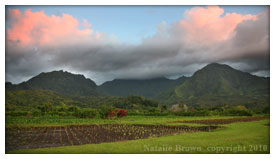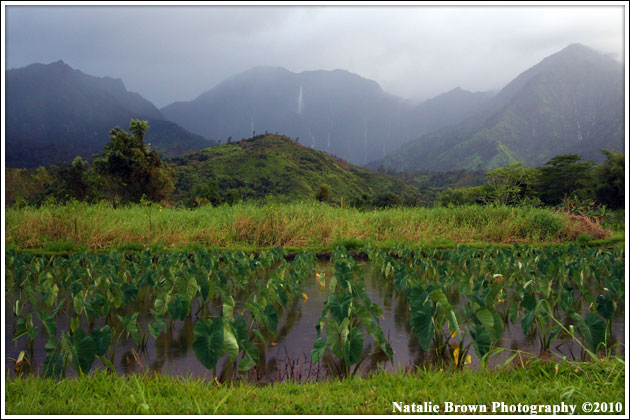
Keeping Taro Sacred And Sovereign: Right Or Risky?
by Naia Kelly
The situation has become a long, drawn out, often times bitter fight. Years have passed and the argument between Monsanto’s researchers, their allies within the University of Hawaii’s scientific community and several Hawaiian cultural groups, and individuals, in the Hawaiian islands over the proposed genetic modification of the sacred taro plant of Hawai’i is still undecided.
The majority of islanders argued that it was against their cultural traditions to change the divine, and taro to the Hawaiians is the epitome of the divine life force. It is the physical representation of the earth transferring the divine mana from which life comes to man. The opposing side’s argument is a secular one of reaping the benefits of profit fueled progress disguised as potentially conserving this struggling genetic line of the sacred taro plant from the ancient pacific isles and the financial effects of an increase in taro production on unemployment rates and corporate spread sheets.
The majority of Hawaiians are opposed to any modification of their sacred taro simply on a religious basis. Since once their minds are made up regarding this, then it’s of no use to speak of any financial benefits resultant of the modification or, as the scientists would argue, the potential for keeping the taro plant from pest and microbial infestation that could result in it’s demise. And, it’s the Hawaiian’s right to decide what Hawaiian flora and fauna are open to being sliced and diced on a genetic level. They are the custodians of the islands both spiritually and physically.
The taro is so sacred to the Hawaiian culture that Molokai’s most famous grassroots eco-warrior, Walter Ritte, and a few friends constructed a “ki’i”, or wooden spirit statue, in protest to legalizing the genetic modification of taro and other foods. The protest made by Ritte was used in hopes of bringing about the awakening of that which is divine in everyone who sees the ki’i so they will more readily identify with the issue at hand and take action to search within and make their voices heard on the matter.
Taro production is down in the Hawaiian islands but the demand is certainly there throughout the globe. Most of the world’s taro comes from Fiji. 1,800,000 pounds of taro are imported into Hawaii each year. Presently there is a moratorium on GM taro in Hawaii, which was put into place two years ago, so that more research and proper review of the issue might be undertaken.
Perhaps during this GM ‘timeout’ Hawaiians should look at what other countries are doing and take a lesson from, say… India? Why? Well, they have increased their rice, potato and other yields by 45% – 100% in their farming villages using a method called SRI, (System of Root Intensification), which requires no chemical fertilizers or herbicides, unlike conventional methods, and less water and also fewer seedlings. And, it doesn’t just work for one species of plant but many, with only slight variations needed depending on soil type and climates.
Perhaps utilizing the less is more theory prior to committing to GMO is the way to approach this problem? SRI is certainly an option and until these kinds of high yield approaches are exhausted, there is no reason to consider genetically modifying any more food. More likely, should SRI prove applicable, it might be worth a look at ways to reverse the GMO infestation of our planet.
Mahalo to Valley Isle Excursions for helping us share Hawaiian views on Taro and the importance of this divine crop.

https://www.spc.int/lrd/index.php?option=com_content&view=article&id=793:whats-holding-pacific-island-taro-exports-back&catid=165:press-releases&Itemid=95
https://www.cornucopia.org/2013/02/indias-rice-revolution/


The US ranks 49th in life expectancy. It is no longer the greatest country in the world. GMO’s are outlawed in Europe because they cause organ failure in animals tested. Kellogs does not use GMO corn in their cereals in Europe, only in the US. Actual headlines, Wallstreet Journal September 25, 2012 – Russia Suspends Import and Use of GMO Corn After Studies Indicated Cancer Risk. So we have to pay a little more for our poi. If we had paid a dollar or two more for local milk instead of buying cheaper mainland imported milk maybe we wouldn’t have put all our local dairies out of business. We need to learn from our mistakes as consumers. I believe there is an agenda for us to work all our lives, pay one third of all we earn in taxes then soon after retirement hurry up and die on schedule. i also believe GMO speeds up the slow genocide of the Hawaiian people. After all, when the blood thins all the Hawaiian homelands go back to the defacto government. Who’s website is this? Aren’t the agendas obvious to EVERYONE? Hello…. poi IS sacred and if you ever ate it you would know why.
That is a very good point. We pay more for organic milk why not for local milk, there are better ways of growing such as treating the soil with bio char. “Perhaps during this GM ‘timeout’ Hawaiians should look at what other countries are doing and take a lesson from, say… India? Why? Well, they have increased their rice, potato and other yields by 45% – 100% in their farming villages using a method called SRI, (System of Root Intensification), which requires no chemical fertilizers or herbicides, unlike conventional methods, and less water and also fewer seedlings. And, it doesn’t just work for one species of plant but many, with only slight variations needed depending on soil type and climates.
Perhaps utilizing the less is more theory prior to committing to GMO is the way to approach this problem? SRI is certainly an option and until these kinds of high yield approaches are exhausted, there is no reason to consider genetically modifying any more food. More likely, should SRI prove applicable, it might be worth a look at ways to reverse the GMO infestation of our planet”.
People have the right to know what is GMO and what is not. If we import over a million tonnes of Taro from other pacific islands, what is to say that Monsanto and Del Monte have not raised their ugly heads there as well.